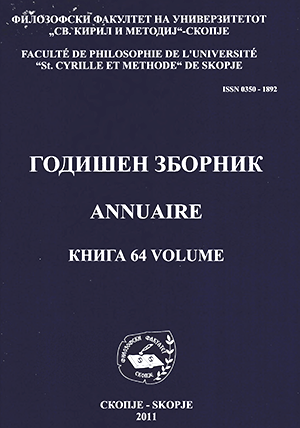EXAMPLES OF THE POPULARIZATION OF MEDIEVAL JEWELRY
DOI:
https://doi.org/10.37510/Keywords:
Necropolis Vodoča, Grave 942, JewelryAbstract
The preserved characteristics of the jewellery φαί belonged to a young girl which was discovered in Grave 942 in фе Vodoca necropolis determine not only the historical period\ the XVI century, but also serve to illustrate her social status and noble heritage.
The pair of remarkable cheek-piece ornaments Illustrations 2, 3, 6y 7 are basically an imitation of the lavish, aristocratic items from the XIV century, above all, circular in shape, bearing elements of the radial ones. The dangles added on to the sides simply represent interesting oriental elements that serve as a substitute for the radially positioned small tubes with a decorative stone, typical among the opulent representations of the Middle Ages.
Even thought they are a cheap, popular, belated replica, these earrings found in Grave 942, displaying with their ornate appearance the aristocratic prototypes of the Middle Ages, do in some ways allude to the proper origins of the deceased girl.
The same can be said about the signet ring. Illustrations 4, 8 According to its form, size and the engraved motif of the wind rose, the ring carries significant meaning, passed on for generations onwards. It also serves to ultimately allude to the noble origins of its wearer.
The simple earring in the shape of an upright strawberry, which hung by the (right) side of the face, near the ear, also reflects the traditional customs and beliefs that existed in the Middle Ages, preserved for centuries afterwards, and having to do with their magical- prophylactic function. Illustrations 1, 5
In the peak of its power, in the XVI century, the Ottoman Empire underwent a unique economic and cultural boom. The prosperity of numerous Christian families in this region and at this time is obvious - descendants of the smaller medieval tribes. Among other things, there are direct testimonials as to their existence in Vodoca as well.
In the census of the population carried out in 1570, the village of Vodoca (Vodica) in the Strumica kaza, in the Sandjak of Kustendil, the existence of 16 hereditary possessions or bashtini has been noted - medieval heridaments. Their Christian owners were buried in the complex: Vodocki Crkvi, St. Leontius Monastery in Vodoca.
The girl buried in Grave 942, with the preserved traditional jewelry having to do with some older beliefs about charms and talismans, Illustrations 1> 5, as well as with the popular opulent forms inspired by the aristocratic and knightly representations, Illustrations 2- 4, 6-8 was without a doubt a member of the most notable families of the population at that time.
Downloads
Published
Issue
Section
License
Copyright (c) 2011 Elica Maneva

This work is licensed under a Creative Commons Attribution 4.0 International License.





